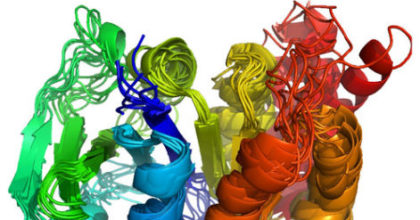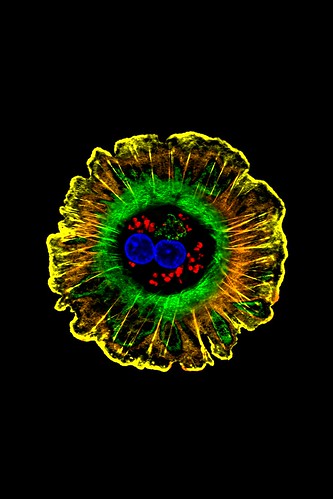
 )
)I am generally bullish on the use of metaphors for understanding the world around us. I find Douglas Hofstadter and Emmanuel Sander’s idea that metaphors are central to language and thought to be fairly compelling. I recognize the potential for a metaphor to lead one down a primrose path. At the same time, how else are we to think and communicate about something like the interior of a biological cell, an environment none of us could ever actually visit or experience? If we cannot avoid metaphors, we can at least be transparent about how we use them and think critically to identify when they have reached the limits of usefulness. In that spirit, I greatly appreciated this paper about the role of machine metaphors in understanding cell biology.
Philosopher of biology Daniel Nicholson makes a case first that machine metaphors are extensive and deliberate in biology, and second that such metaphors do not provide a framework which readily accommodates everything that we have come to know about cells. Central to this discussion are the methods we use to study cells. Prior techniques provided fairly static views, while more recent methods allow scientists a dynamic perspective. For example, X-ray crystallography has been used extensively to explore the structure of proteins. Protein crystals have a lot in common with the salt and sugar crystals in your kitchen; they are rigid and inert. So naturally the images we get are solid and stable–protein still lifes. Using NMR, we can get a sense of how proteins behave over time and in solution as they are in a cell; more of a protein movie. And those movies reveal structures that reconfigure frequently, or in some cases never actually settle down at all. Such proteins may never form crystals in the first place, making them inaccessible to study by X-ray.
Both X-ray crystallography and NMR are still fairly reductionist, since they examine individual proteins in isolation. We can also look at whole cells under a microscope and even label specific proteins to see where they are. When I was in college, I did a little bit of this sort of work. We used antibodies with fluorescent tags to see the proteins. A key step in this process was “fixing” the cells, which meant applying a chemical(s) that killed the cells and made various internal parts stick to each other to hold the whole ensemble in place. One can get beautiful images this way (I generally did not), but again they are snapshots. It’s been a little while since I was in college, and newer techniques are now available that allow for more dynamic visualization. What we’ve seen is that cells are less architectural; there are still discrete compartments but they are running to stand still. They persist because they are constantly being rebuilt and disassembled, not constructed once and deployed.

 )
)Perhaps you can already see how this relates to machine metaphors. A machine is built once from parts that are meant to have a single shape or to move in predictable ways. They operate in a fixed cycle or sequence of steps with clearly defined starts and stops. The contrast with proteins and cells is that proteins are in constant motion, interacting with whatever is around them in ways that are strongly dependent on context. Structures are assembled and then taken apart just as quickly; anything that persists does so dynamically. Thus thinking about a tiny version of your dishwasher or car engine when thinking about what goes on inside a cell will not give you a complete picture.
One might also note that machine metaphors are a common element of discussions about Design in biology. With that in mind, a paper arguing against such metaphors may seem motivated as a counter-move in those discussions. While I obviously can’t speak to Nicholson’s internal motivations, the examples he chooses to interact with do not come from that particular conversation. Some of the most substantial quotes come from Jacques Monod and Bruce Alberts, two very influential biologist-authors. Alberts wrote a widely used cell biology textbook; I had a course taught from that book. The books of these two men were significant to large cohorts of biologists. So these machine metaphors are absolutely an element of mainstream biology research and teaching and as such will not be replaced quickly.
And it is not simply that undergrads or lay readers may be confused or led astray. Machine metaphors turn up in literature as well and probably even constrain the kinds of experiments that are performed and the way results are interpreted. Nicholson notes a shift in the language used in gene expression literature, away from terminology drawn from engineering disciplines. This shift allows for certain observations to move from being dismissed as noise to accepted as part of the behavior of cells to be understood. Perhaps a feedback loop is created; changing the metaphor changes the acquisition and interpretation of the data which changes the metaphor further.
Moving away from machine metaphors doesn’t mean we need to appreciate cells any less. Just because they don’t work the way our creations work doesn’t mean they aren’t remarkable and incredible. They still accomplish everything we already know they accomplish; they still make our lives possible. They may just get there in ways less familiar to us, ways we wouldn’t have come up with if it were up to us. So if its time is done, don’t mourn for the machine metaphor. Be excited for the new learning opportunities the next metaphor(s) will provide.
Andy has worn many hats in his life. He knows this is a dreadfully clichéd notion, but since it is also literally true he uses it anyway. Among his current metaphorical hats: husband of one wife, father of two teenagers, reader of science fiction and science fact, enthusiast of contemporary symphonic music, and chief science officer. Previous metaphorical hats include: comp bio postdoc, molecular biology grad student, InterVarsity chapter president (that one came with a literal hat), music store clerk, house painter, and mosquito trapper. Among his more unique literal hats: British bobby, captain’s hats (of varying levels of authenticity) of several specific vessels, a deerstalker from 221B Baker St, and a railroad engineer’s cap. His monthly Science in Review is drawn from his weekly Science Corner posts — Wednesdays, 8am (Eastern) on the Emerging Scholars Network Blog. His book Faith across the Multiverse is available from Hendrickson.

It’s true that machines and competition have been the dominant metaphors in biology for more than a century, coincident with the rise in industry and capitalism in society. Now at least some biologists are exploring more ecological metaphors that stress relationships and cooperation. Metaphors both reflect and shape the culture.